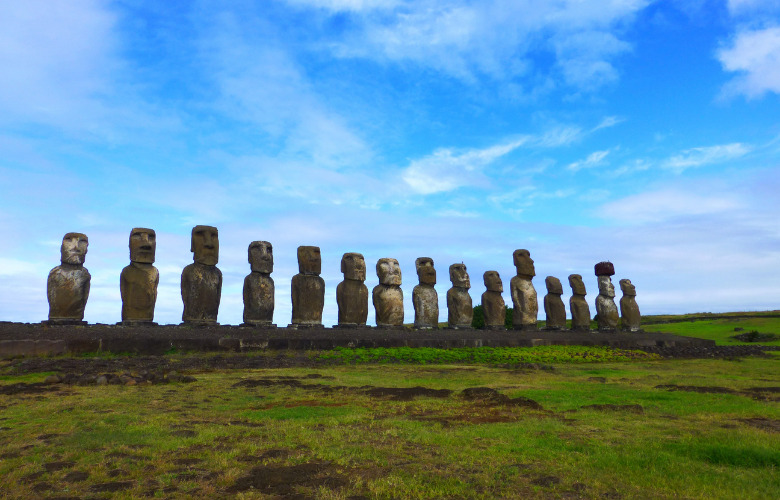
Easter Island (Rapa Nui) is an island and special territory of Chile. Far away, in the south-eastern Pacific Ocean. At the southeasternmost point of the Polynesian Triangle in Oceania. It is one of the most remote inhabited islands in the world. Farthest away from any larger land mass. It is also a place steeped in mystery. Here is a short history of this fascinating corner of the world plus a short introduction into its theatre practices and traditions.
Easter Island is most famous for its nearly 1,000 extant monumental statues, called moai, which were created by the early Rapa Nui people.
In 1995, UNESCO named Easter Island a World Heritage Site, with much of the island protected within Rapa Nui National Park.
Experts disagree on when the island’s Polynesian inhabitants first reached the island. While many in the research community cited evidence that they arrived around the year 800, convincing data presented in a 2007 study suggests their arrival to have been closer to 1200.
The indigenous people of Easter Island created a thriving and industrious culture, as evidenced by the island’s numerous enormous stone moai and other artifacts.
However, land clearing for cultivation and the introduction of the Polynesian rat led to gradual deforestation.
By the time of European arrival in 1722, the island’s population was estimated to be 2,000 to 3,000.
European diseases, Peruvian slave raiding expeditions in the 1860s, and emigration to other islands such as Tahiti further depleted the population, reducing it to a low of only 111 native inhabitants in 1877.
Chile annexed Easter Island in 1888. In 1966, the people of Rapa Nui were granted Chilean citizenship. In 2007 the island gained the constitutional status of “special territory.”
Administratively, it belongs to the Valparaiso Region, constituting a single commune (Isla de Pascua) of the Province of Isla de Pascua.
The 2017 Chilean census registered 7,750 people on the island, of whom 3,512 (45%) considered themselves Rapa Nui. Still an incredible small number, but thankfully this intriguing people and their traditions have survived thus far.
When it comes to Easter Island indigenous theatre not much is known. Even extensive Google searches do not unearth much at all.
However, recently Moira Fortin has shed some light on this. First with her thesis The development of theatre in Easter Island: Hakararama i Te A’amu o Rapa Nui, which she published in 2009.
Followed by her book Rapa Nui Theatre: Staging Indigenous Identities in Easter Island, which is now available for pre-order and will most likely hit virtual and physical book shelves on August 18, 2022.
Hakararama i Te A’amu o Rapa Nui means to show Rapa Nui stories.
Easter Island has a unique way of presenting their stories. They use different types of performances throughout their theatre shows. Such as kai kai (string figures), takona (body painting), riu and ute (songs), pata’u ta’u (recitations) and a’amu (the narrative itself in te re’o, the native Rapa Nui language).
The combination of all these different elements results in a dynamic show that contains not only verbal text, but also visual text, using kai kai and takona, for instance, as an aid for the understanding of the story.
Language is one of the key aspects in which Easter Island indigenous people perform, using te re’o during the entire show.
Performing their oral traditions and histories might be one way through which their culture is preserved and will hopefully continue to live and develop.
Moira Fortin’s work is the first in-depth research of Theatre in Easter Island.
Her research contributes to clarifying some concepts of Rapa Nui performing arts, explaining the background behind each presentation, as well as outlining the rules and features that this type of theatre has.
Here you can download Moira’s thesis free of charge.
The development of theatre in Easter Island: Hakararama i Te A’amu o Rapa Nui, by Moira Fortin
Rapa Nui Theatre: Staging Indigenous Identities in Easter Island, by Moira Fortin
History.com on Rapa Nui
Rapa Nui (Easter Island) on Wikipedia
Opera Village Africa – a Vision by Director Christoph Schlingensief
Wunika Mukan, Nigeria-Based Curator, on Giving African Artists a Voice


Liam Klenk was born in Central Europe and has since lived on four continents. Liam has always been engaged in creative pursuits, ranging from photography and graphic design, to writing short stories and poetry, to working in theatre and shows. In 2016, Liam published his first book and memoir, 'Paralian'.
Read Full Profile© 2021 TheatreArtLife. All rights reserved.

Thank you so much for reading, but you have now reached your free article limit for this month.
Our contributors are currently writing more articles for you to enjoy.
To keep reading, all you have to do is become a subscriber and then you can read unlimited articles anytime.
Your investment will help us continue to ignite connections across the globe in live entertainment and build this community for industry professionals.